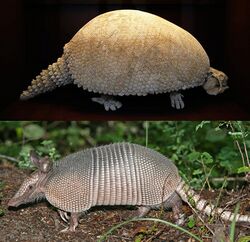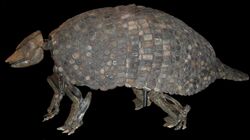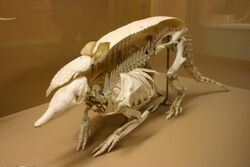Biology:Cingulata
| Cingulata | |
|---|---|

| |
| Glyptodon (Vienna) and Dasypus novemcinctus | |
| Scientific classification | |
| Domain: | Eukaryota |
| Kingdom: | Animalia |
| Phylum: | Chordata |
| Class: | Mammalia |
| Superorder: | Xenarthra |
| Order: | Cingulata Illiger, 1811 |
| Families | |
Cingulata, part of the superorder Xenarthra, is an order of armored New World placental mammals. Dasypodids and chlamyphorids, the armadillos, are the only surviving families in the order.[1] Two groups of cingulates much larger than extant armadillos (maximum body mass of 45 kg (100 lb) in the case of the giant armadillo[2]) existed until recently: pampatheriids, which reached weights of up to 200 kg (440 lb)[3] and chlamyphorid glyptodonts, which attained masses of 2,000 kg (4,400 lb)[4] or more.
The cingulate order originated in South America during the Paleocene epoch about 66 to 56 million years ago, and due to the continent's former isolation remained confined to it during most of the Cenozoic. However, the formation of a land bridge allowed members of all three families to migrate to southern North America during the Pliocene[5] or early Pleistocene[6] as part of the Great American Interchange. After surviving for tens of millions of years, all of the pampatheriids and giant glyptodonts apparently died out during the Quaternary extinction event at the beginning of the Holocene,[7][8] along with much of the rest of the regional megafauna, shortly after the colonization of the Americas by Paleo-Indians.
Description
Armadillos have dorsal armor that is formed by osteoderms, plates of dermal bone covered in relatively small, overlapping keratinized epidermal scales called "scutes". Most species have rigid shields over the shoulders and hips, with three to nine bands separated by flexible skin covering the back and flanks.[9]
Pampatheres also had shells that were flexible due to three movable lateral bands of osteoderms.[3] The osteoderms of pampatheres were each covered by a single scute, unlike those of armadillos, which have more than one.[3] Glyptodonts, on the other hand, had rigid, turtle-like shells of fused osteoderms.
Both groups have or had a cap of armor atop their heads. Glyptodonts also had heavily armored tails; some, such as Doedicurus, had mace-like clubs at the ends of their tails, similar to those of ankylosaurs, evidently used for defensive or agonistic purposes.[4]
Most armadillos eat insects and other invertebrates; some are more omnivorous and may also eat small vertebrates and vegetable matter. Pampatheres are thought to have been specialized for grazing,[3] and isotopic analysis indicates the diet of glyptodonts was dominated by C4 grasses.[10] Euphractinae is unique for speciations towards carnivory, culminating in the macropredatory genus Macroeuphractus.
Classification



| Cladogram of Cingulata[11][12][13] | |||||||||||||||||||||||||||||||||||||||||||||||||||||||||||||||||||||||||||||||||||||||||||||||||||||||||||||||||||||||||||||||||||||||
|
The taxonomic table below follows the results of a phylogenetic analysis published by Delsuc et al., 2016. While glyptodonts have traditionally been considered stem-group cingulates outside the group that contains modern armadillos, this 2016 study conducted an analysis of Doedicurus mtDNA and found that it was, in fact, nested within the modern armadillos as the sister group of a clade consisting of Chlamyphorinae and Tolypeutinae.[11]
Order Cingulata
- Family †Peltephilidae Ameghino 1894
- Genus †Anantiosodon Ameghino 1891
- Genus †Epipeltephilus Ameghino 1904
- Genus †Parapeltecoelus Bordas 1938
- Genus †Peltecoelus Ameghino 1902
- Genus †Peltephilus Ameghino 1887 (Horned armadillo)
- Genus †Ronwolffia Shockey 2017
- Family †Paleopeltidae Ameghino 1895
- Genus †Palaeopeltis Ameghino 1895
- Family †Pampatheriidae
- Genus ?†Machlydotherium Ameghino 1902
- Genus †Holmesina Simpson 1930
- Genus †Kraglievichia Castellanos 1927
- Genus †Machlydotherium
- Genus †Pampatherium Ameghino 1875 ex Gervais & Ameghino 1880
- Genus †Scirrotherium Edmund & Theodor 1997
- Genus †Tonnicinctus Góis et al. 2015[14]
- Genus †Vassallia Castellanos 1927 [Plaina Castellanos 1937]
- Genus †Yuruatherium Ciancio et al. 2012
- Family †Pachyarmatheriidae Fernicola et al. 2018
- Genus †Neoglyptatelus Carlini, Vizcaíno & Scillato-Yané 1997
- Genus †Pachyarmatherium Downing & White 1995
- Family Dasypodidae (long-nosed armadillos)
- Genus †Acantharodeia
- Genus †Amblytatus
- Genus †Archaeutatus
- Genus †Astegotherium
- Genus †Astegotherium
- Genus †Barrancatatus
- Genus †Chasicotatus
- Genus †Chorobates
- Genus †Coelutaetus
- Genus †Eocoleophorus
- Genus †Epipeltecoelus
- Genus †Eutatus
- Genus †Hemiutaetus
- Genus †Isutaetus
- Genus †Lumbreratherium
- Genus †Macrochorobates
- Genus †Mazzoniphractus
- Genus †Meteutatus
- Genus †Pedrolypeutes
- Genus †Prodasypus
- Genus †Proeutatus
- Genus †Prostegotherium
- Genus †Pucatherium
- Genus †Punatherium
- Genus †Stegotherium
- Genus †Stenotatus
- Genus †Utaetus
- Genus †Vetelia
- Subfamily Dasypodinae
- Genus †Anadasypus
- Genus Dasypus
- Genus †Nanoastegotherium
- Genus †Parastegosimpsonia
- Genus †Pliodasypus
- Genus †Propraopus
- Genus †Riostegotherium
- Genus †Stegosimpsonia
- Family Chlamyphoridae: glyptodonts and other armadillos
- Subfamily Chlamyphorinae: fairy armadillos
- Genus Calyptophractus
- Genus Chlamyphorus
- Subfamily Euphractinae: hairy, six-banded and pichi armadillos
- Genus Chaetophractus
- Genus †Doellotatus
- Genus Euphractus
- Genus †Macroeuphractus
- Genus †Peltephilus
- Genus †Proeuphractus
- Genus †Paleuphractus
- Genus Zaedyus
- Subfamily †Glyptodontinae: glyptodonts
- Genus †Doedicurus
- Genus †Glyptodon
- Genus †Glyptotherium
- Genus †Hoplophorus
- Genus †Panochthus
- Genus †Parapropalaehoplophorus
- Genus †Plaxhaplous
- Subfamily Tolypeutinae: giant, three-banded and naked-tailed armadillos
- Genus Cabassous
- Genus †Kuntinaru[15]
- Genus Priodontes
- Genus Tolypeutes
- Subfamily Chlamyphorinae: fairy armadillos
References
- ↑ Gardner, A.L. (2005). "Order Cingulata". in Wilson, D.E.; Reeder, D.M. Mammal Species of the World: A Taxonomic and Geographic Reference (3rd ed.). Johns Hopkins University Press. pp. 94–99. ISBN 978-0-8018-8221-0. OCLC 62265494. http://www.departments.bucknell.edu/biology/resources/msw3/browse.asp?id=11700001.
- ↑ Giant Armadillo Priodontes maximus (Kerr, 1792). FaunaParaguay.com
- ↑ 3.0 3.1 3.2 3.3 Vizcaíno, S. F.; De Iuliis, G.; Bargo, M. S. (1998). "Skull Shape, Masticatory Apparatus, and Diet of Vassallia and Holmesina (Mammalia: Xenarthra: Pampatheriidae): When Anatomy Constrains Destiny". Journal of Mammalian Evolution 5 (4): 291–322. doi:10.1023/A:1020500127041.
- ↑ 4.0 4.1 Blanco, R. E.; Jones, W. W.; Rinderknecht, A. (2009-08-26). "The sweet spot of a biological hammer: the centre of percussion of glyptodont (Mammalia: Xenarthra) tail clubs". Proceedings of the Royal Society B: Biological Sciences 276 (1675): 3971–3978. doi:10.1098/rspb.2009.1144. ISSN 0962-8452. PMID 19710060.
- ↑ Mead, J. I.; Swift, S. L.; White, R. S.; McDonald, H. G.; Baez, A. (2007). "Late Pleistocene (Rancholabrean) Glyptodont and Pampathere (Xenarthra, Cingulata) from Sonora, Mexico". Revista Mexicana de Ciencias Geológicas 24 (3): 439–449 (see p. 440). http://www.scielo.org.mx/pdf/rmcg/v24n3/v24n3a11.pdf. Retrieved 2013-06-15.
- ↑ Woodburne, M. O. (2010-07-14). "The Great American Biotic Interchange: Dispersals, Tectonics, Climate, Sea Level and Holding Pens". Journal of Mammalian Evolution 17 (4): 245–264 (see p. 249). doi:10.1007/s10914-010-9144-8. ISSN 1064-7554. PMID 21125025.
- ↑ Hubbe, A.; Hubbe, M.; Neves, W. A. (March 2013). "The Brazilian megamastofauna of the Pleistocene/Holocene transition and its relationship with the early human settlement of the continent". Earth-Science Reviews 118: 1–10 (see pages 3, 6). doi:10.1016/j.earscirev.2013.01.003. ISSN 0012-8252. Bibcode: 2013ESRv..118....1H.
- ↑ Fiedal, Stuart (2009). "Sudden Deaths: The Chronology of Terminal Pleistocene Megafaunal Extinction". in Haynes, Gary. American Megafaunal Extinctions at the End of the Pleistocene. Vertebrate Paleobiology and Paleoanthropology. Springer. pp. 21–37 (see p. 31). doi:10.1007/978-1-4020-8793-6_2. ISBN 978-1-4020-8792-9. OCLC 313368423.
- ↑ Dickman, Christopher R. (1984). Macdonald, D.. ed. The Encyclopedia of Mammals. New York: Facts on File. pp. 781–783. ISBN 978-0-87196-871-5. https://archive.org/details/encyclopediaofma00mals_0/page/781.
- ↑ Pérez-Crespo, V. A.; Arroyo-Cabrales, J.; Alva-Valdivia, L. M.; Morales-Puente, P.; Cienfuegos-Alvarado, E. (2011-10-18). "Diet and habitat definitions for Mexican glyptodonts from Cedral (San Luis Potosí, México) based on stable isotope analysis". Geological Magazine 149 (1): 153–157. doi:10.1017/S0016756811000951. ISSN 0016-7568.
- ↑ 11.0 11.1 Delsuc, F.; Gibb, G. C.; Kuch, M.; Billet, G.; Hautier, L.; Southon, J.; Rouillard, J.-M.; Fernicola, J. C. et al. (2016-02-22). "The phylogenetic affinities of the extinct glyptodonts". Current Biology 26 (4): R155–R156. doi:10.1016/j.cub.2016.01.039. PMID 26906483. https://hal.archives-ouvertes.fr/hal-01879335.
- ↑ Upham, Nathan S.; Esselstyn, Jacob A.; Jetz, Walter (2019). "Inferring the mammal tree: Species-level sets of phylogenies for questions in ecology, evolution and conservation". PLOS Biol 17 (12): e3000494. doi:10.1371/journal.pbio.3000494. PMID 31800571.
- ↑ Gibb, Gillian C.; Condamine, Fabien L.; Kuch, Melanie; Enk, Jacob; Moraes-Barros, Nadia; Superina, Mariella; Poinar, Hendrik N.; Delsuc, Frédéric (2015). "Shotgun Mitogenomics Provides a Reference PhyloGenetic Framework and Timescale for Living Xenarthrans". Molecular Biology and Evolution 33 (3): 621–642. doi:10.1093/molbev/msv250. PMID 26556496.
- ↑ Flávio Góis; Laureano Raúl González Ruiz; Gustavo Juan Scillato-Yané; Esteban Soibelzon (2015). "A Peculiar New Pampatheriidae (Mammalia: Xenarthra: Cingulata) from the Pleistocene of Argentina and Comments on Pampatheriidae Diversity". PLOS ONE 10 (6): e0128296. doi:10.1371/journal.pone.0128296. PMID 26083486. Bibcode: 2015PLoSO..1028296G.
- ↑ Guillaume Billet; Lionel Hautier; Christian de Muizon; Xavier Valentin (2011). "Oldest cingulate skulls provide congruence between morphological and molecular scenarios of armadillo evolution". Proceedings of the Royal Society 278 (1719): 2791–2797. doi:10.1098/rspb.2010.2443. PMID 21288952.
| Wikimedia Commons has media related to Cingulata. |
Wikidata ☰ Q1242326 entry
 |

